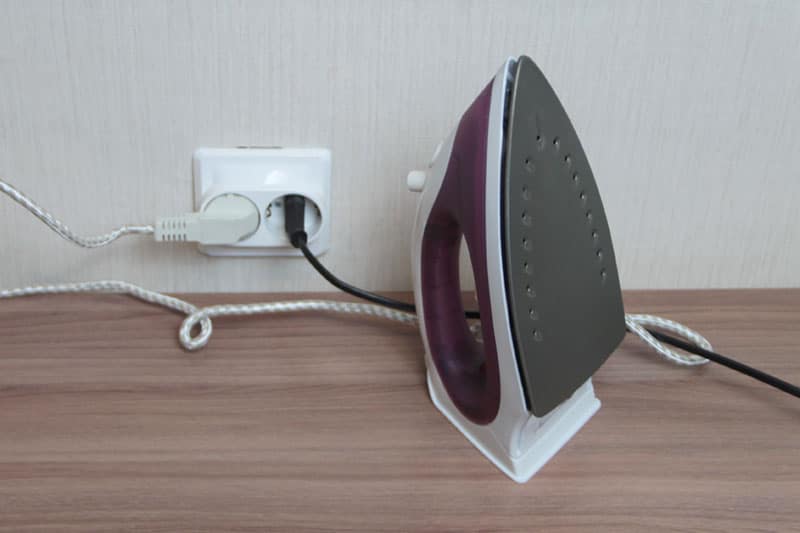There’s a mountain of creased clothes in your utility room, but your iron won’t turn on. Before you give up and decide to flaunt the crumpled look for the day, please take a look at the 6 methods in this article that will help you to fix the issue.
If your iron won’t turn on:
- Check the circuit breaker
- Inspect the power cord
- Deactivate the auto shutoff mode
- Change the settings
- Replace the heating element
- Replace the thermostat
Ready to get your iron back to normal? Let’s go!
6 Ways to Get Your Iron to Turn On
So, you can’t get your iron to turn on, and you’re unsure what to do about it. You’re in two minds; you could spend a couple of hours pulling the iron to pieces and poking it with a multimeter, trying to find out what’s wrong. Or, you could just put on creased clothes from now on and hope that they straighten themselves out a little as you wear them.
I’m sure you’ll agree that neither are good ideas. So instead, here are my 6 favorite methods to fix an iron not turning on.
Method #1 Check the Circuit Breaker
When your iron is not turning on, I recommend you start by checking your circuit breakers.
You should check for a tripped switch in your circuit breaker. If one switch has tripped, reset it. If the circuit breaker keeps tripping when you plug in the iron, do the following:
- Plug the iron into a different power outlet. Make sure the outlet is on a new circuit.
- Plug the iron into a power outlet in a different room. If you are using an extension cord, do not overload it.
- Turn the iron off and discontinue its use. If the iron continues to trip the circuit breaker, it may have an internal electrical issue. You should contact a technician to resolve the problem.

Method #2 Inspect the Power Cord
Next up on the list to check for when your iron is not turning on is the power cord. A fault with your iron’s power cord could be why your iron is not turning on. You should inspect the cord to ensure everything is in good working order.
But what exactly should you look out for?
- Make sure that you plug the power cord correctly. The iron will not work properly if the plug is half in and half out.
- Check that the power cord does not show any signs of damage. Damage includes bite marks or fraying.
- Ensure that the cord is not worn or broken.
If your power cord or plug shows signs of damage, you must remove and replace the cord. I do not recommend you continue using an iron with a damaged power cord.

Method #3 Deactivate Auto Shutoff Mode
Another possible reason why your iron is not turning on is that its auto shutoff mode is activated.
I find that most modern irons have an auto shutoff feature that kicks in after a period of inactivity, such as:
- Not using the iron for 5 to 10 minutes while it is switched on.
- Leaving the iron horizontally without moving it for more than 30 seconds while it is switched on.
- Leaving the iron vertically on the heel rest for more than 8 minutes while switched on.
You will have to deactivate auto shutoff mode to get your iron back on its feet. Deactivating the safety feature is quick and easy and will allow you to use the iron again normally. To reactive auto shutoff mode, simply shake the iron back and forth a couple of times. Alternatively, if your iron has an ON/OFF button, press the button.
To stop automatic deactivation, my usual advice is to avoid leaving the iron on and unattended. Just remember to keep an eye on the iron, as burned clothes pose a fire hazard that could compromise the safety of your home.

Method #4 Change the Settings
If your iron has stopped working, it could be because it’s stuck on the wrong setting. Sometimes, your iron can be set to a cooler temperature than normal by accident. If you reckon bad temperature settings could be the problem, adjust the temperature dial on the iron.
After a couple of minutes, the iron should be hot and ready to use.
Method #5 Replace the Heating Element
If your iron is still not turning on, it could be because of a faulty heating element. If the heating element in your iron is faulty, you must replace it. However, in my experience, replacing such an element is not easy. First because finding the part for your exact iron will be tricky, and second because performing the repair can also be very fiddly.
If the element is faulty, I recommend you look for a new iron – especially if you own a cheap one.

Method #6 Replace the Thermostat
If your iron is still not turning on, my last recommendation would be to replace the thermostat.
The thermostat in your iron controls its temperature. So, if the thermostat is faulty, it will not heat the iron up when you turn it on.
If you’re having problems with your iron’s thermostat, you must replace it. To replace your iron’s thermostat:
- Turn your thermostat from a very low setting to a very high setting. If the iron turns on, but you do not hear any noise coming from it, the thermostat could be to blame.
- Turn your thermostat from a very low setting to a very high setting. If the iron’s sole plate doesn’t change temperature, you might need to replace the thermostat.
Installing a new thermostat is simple. But finding an exact replacement for your iron might prove tricky – especially if your iron is an older model. As with the heating element, sometimes it’ll be easier for you to replace the iron completely rather than dig for spare parts.
Turning Your Iron Back On
Having your iron stop working can be very frustrating. Mustering up the energy to start the ironing is tough enough as it is. And now, you also have to figure out how to fix the iron.
Hopefully, this article has helped you better understand how simple it is to fix your iron. Remember, in most cases, a damaged power cord, tripped breakers, or a bad heating element are to blame.
If this article proved useful, please check out our other incredible resources below and consider subscribing to our newsletter.
Have a great day!
-Craig.







